Painting is one of the most traditional and valued types of art in the world. Through it great artists expressed ideas and feelings, thus leaving a priceless legacy.
According to the Spanish painter Pablo Picasso:
Painting is never prose. It is poetry that is written with plastic rhyme verses.
We selected 15 paintings made in oil paint that have entered the history of Western art. Such works are perpetuated as cultural symbols, either because they bring artistic innovations, political questions or because they represent aspirations and feelings common to humanity.
1. Mona Lisa by Leonardo Da Vinci

The board Mona Lisa - entitled THE Gioconda originally - is a creation of Leonardo da Vinci, one of the most celebrated personalities of the Italian Renaissance.
In it, a woman is portrayed with an enigmatic facial expression, exhibiting a very intriguing slight smile that invites us to imagine what her thoughts and feelings might be. Was Mona Lisa showing satisfaction, innocence or a certain arrogance?
Many theorists and art critics tried to unravel this mystery and several artistic productions were made inspired by this painting that can be considered one of the greatest masterpieces in the history of art western.
2. Guernica by Pablo Picasso

Guernica is one of the most emblematic paintings by the Spanish painter Pablo Picasso, a great exponent of cubism.
In this work, he portrays the horrors of the Spanish Civil War, especially the bombing of the Basque city of Guernica on April 26, 1937.
This large canvas became a symbol in the fight against all types of war and revolutionized historical painting, as it treats suffering in a timeless way.
3. Gustav Klimt's Kiss

The canvas, painted by the Austrian Gustav Klimt in 1907, it is a famous work in the history of art. This painting has been reproduced and stamped on objects incessantly, representing an icon of Western culture.
The work is part of the so-called "golden phase" in Klimt's artistic production, when he abuses sparkling elements that refer to precious stones and even gold leaves in his compositions.
In The kiss, a couple is portrayed (which would be the artist himself and his wife), in an intertwined position, suggesting affection and warmth.
However, with a closer look, it is also possible to observe that the man bends over the beloved, being the active figure in this embrace, and the woman, kneeling, would be a sign of female submission.
4. Edvard Munch's Scream
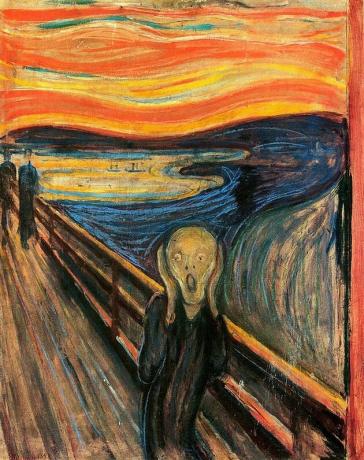
The Scream is the most famous painting by Edvard Munch, a Norwegian painter. This work has been reproduced over time, including by other artists such as Andy Warhol.
His success was probably because Munch was able to portray very successfully the feeling of anguish and loneliness that people are subjected to.
With colors, shapes and lines, the painter built a symbol of human despair in this composition, which is also an icon of the avant-garde expressionist movement.
5. Jackson Pollock No. 5
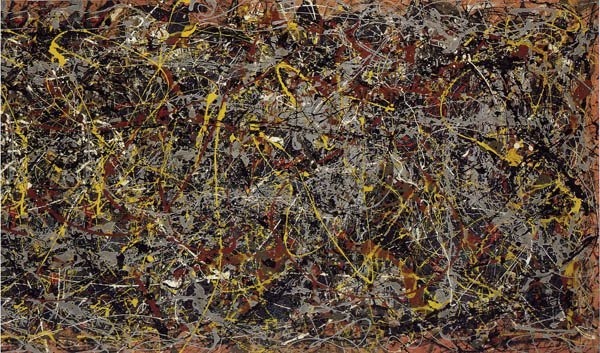
In 1948, in the postwar period, the American Jackson Pollock produced the canvas entitled No. 5.
The artist was one of the precursors of abstract expressionism, an artistic movement that emerged in the 40s in the USA.
This work was made using the technique dripping (drip), much explored by the painter. The method consists of pouring liquid paint on large canvases stretched on the floor. In this way, the painter performs extensive bodily movements, almost as if he "entered" the work at the moment of creation.
In May 2006, the painting was sold for a staggering $140 million, the highest price paid for a painting until 2011.
6. The Girls of Diego Velázquez

Initially titled Philip IV's family, the board The girls, was painted in 1656 by artist Diego Velázquez. This work represents the golden age of the painter, born in the city of Seville, Spain.
The painting depicts a possibly everyday 17th-century court scene. Apparently simple, the canvas carries a series of elements to be "discovered" by the viewer, which makes it one of the most profound works in the history of art.
In the painting, the painter portrayed himself working on a canvas commissioned by the kings Filipe IV and Mariana, which appear reflected in a mirror in the back of the room. This feature also gives us the feeling that they would be spectators of the work itself.
7. Vincent Van Gogh's Potato Eaters
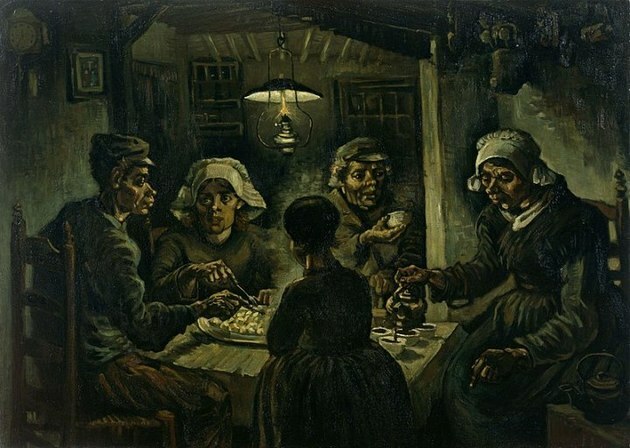
This work was produced in 1885 by Vincent Van Gogh, Dutch painter of post-impressionism and expressionism. Much acclaimed today, Van Gogh was a solitary artist and had very little recognition in his lifetime.
The painting in question depicts a peasant family eating in their humble home, lit by a dim lamp. It is a well-known work by the painter and shows the technical evolutions of his painting, imprinting expressionist characteristics that would become his trademark.
In addition, he shows great interest in social and humanitarian issues. According to the artist himself:
I wanted to consciously dedicate myself to expressing the idea that these people who, in this light, eat their potatoes with their hands, also worked the land. My picture therefore extols the manual labor and food they themselves so honestly earned.
8. The Persistence of Memory of Salvador Dalí

Salvador Dali was a Catalan painter who was part of surrealism in Europe. One of his most famous paintings is THEPersistence of Memory.
In this work, Dalí represents the passage of time through the disturbing figure of melted clocks in an arid landscape, a shapeless body, ants and a fly.
In the background it is also possible to notice the presence of a cliff and the sea, a landscape that makes reference to its place of origin, Catalonia.
This work has been found since 1934 at the Museum of Modern Art in New York, in the United States.
9. Impression, Rising Sun by Claude Monet
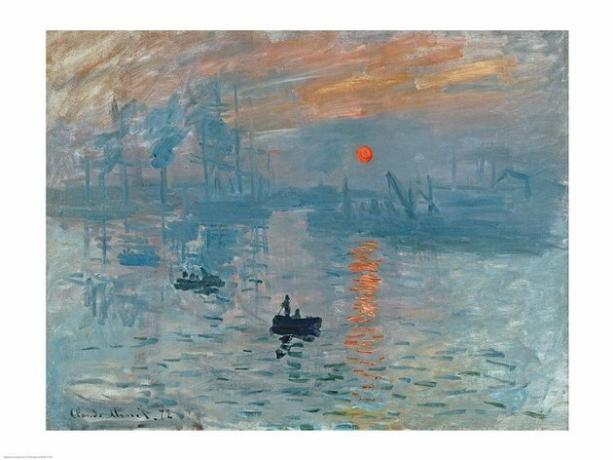
Claude Monet, an important painter of impressionism, a European avant-garde artistic movement, conceived this work in 1872.
The composition is a landmark in painting, as it exhibits a new way of brushing by recording the moment when the sun crosses the fog in the Bay of Le Havre, in Normandy.
It can be considered that the innovation present in this work revolutionized painting.
The reaction of the press at the time was against the new style and considered this canvas an "unfinished" work. The exhibition in which she was shown was pejoratively called the "impressionist exhibition" and elected Printing, Rising Sun as the biggest target of criticism. Because of this episode, the impressionist current was named that way.
10. Francisco de Goya's May 3rd executions
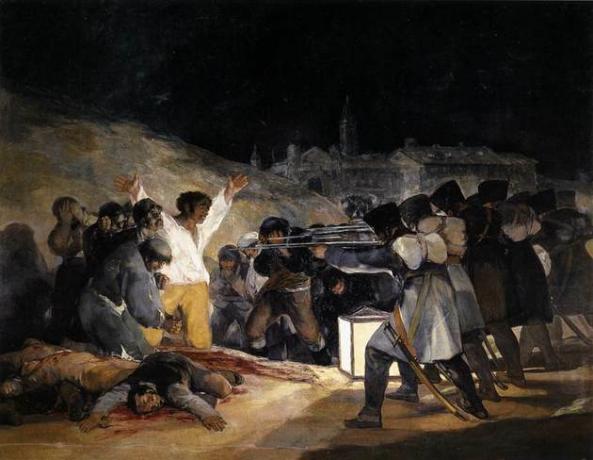
The Executions of the Three of May, the Three of May of 1808 in Madrid or The Executions of the Mountain of Príncipe Pío, is a painting by the Spanish painter Francisco de Goya.
In this painting, Francisco de Goya presents an impressive portrait of the genocide that took place in Madrid, in the year 1808. This event was a consequence of the so-called Peninsular War (1807-1814), when Napoleon Bonaparte invaded Spain.
The day before this terrible massacre, some from Madrid clashed with Napoleonic troops. Wielding only melee weapons, they faced the enemy cavalry and were harshly repressed.
This episode was also portrayed by Goya in the work May 2nd in Madrid and form a duet with The shootings of May 3rd.
As a rebuke to the "daring" of civilians, the massacre that culminated in the death of countless innocents was carried out. Goya, who lived very close to the place, witnessed such episodes and years later conceived this canvas, which would become a milestone in art history and a denunciation of the horrors of war - influencing other artists like Picasso in production of your Guernica.
When asked why he painted these atrocities, Goya replied:
To have the pleasure of telling men forever not to be barbarians.
11. Young Girl with Pearl Earring by Johannes Vermeer
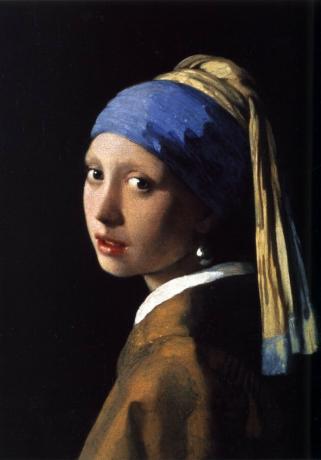
The board Girl with Pearl Earring is considered "the Dutch Mona Lisa" as it also displays a female figure shrouded in a mysterious atmosphere.
Johannes Vermeer, a Dutch artist, is believed to have produced this portrait in 1665 - the canvas has not been dated. In it, we observe a girl who looks back at us with a serene and chaste air, bringing a shine to her parted lips.
Another guess is about the adornment on the young woman's head. At that time a turban was no longer used, so it is speculated that Vermeer was inspired by another work, boy in a turban, painted by Michael Sweerts in 1655.
This is the painter's best-known work and inspired the production of a book and a film, both with the same name as the painting.
12. The Boatmen's Lunch by Pierre-Auguste Renoir
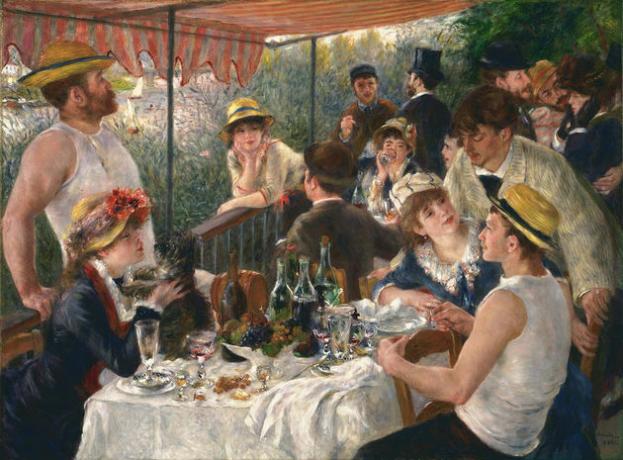
In 1881, Pierre-Auguste Renoir finishes painting the frame The Boaters' Lunch, important exponent of the impressionist movement.
In the work, the painter elaborates a happy and relaxed scene by showing a meeting between friends, washed down with lots of food and a beautiful view of the Seine River. All of the people portrayed were close friends of Renoir and one of the women who appears on the screen became his wife years later.
This artistic trend was concerned with capturing natural lighting and spontaneous scenes through the fixation of the moment. We can say that Impressionism was the avant-garde movement that gave a boost to the so-called modern art.
13. Henry Ford Hospital (The Flying Bed) by Frida Kahlo
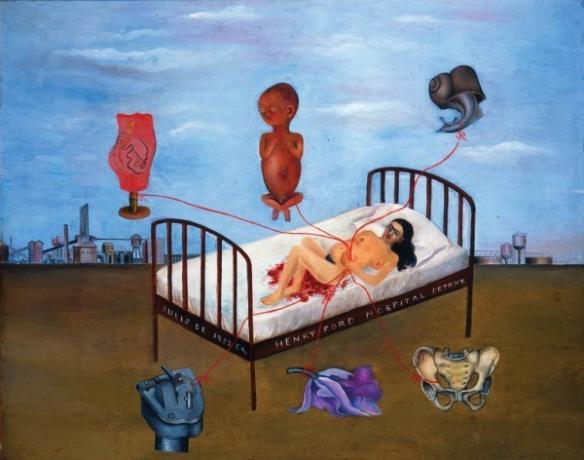
Frida Kahlo she was an important Mexican artist who lived in the first half of the 20th century.
Her painting, almost always autobiographical, portrays her pain, her great love (also painter Diego Rivera), her pride for being a woman and for her Latin American origins.
Frida's production is loaded with symbolisms and elements that flirt with surrealism, although the painter denies being part of such a movement and being closer to a type of confessional art. She states:
I never paint dreams or nightmares. I paint my own reality.
In the work that became known as The Flying Bed, the artist portrays a painful episode in her life, when she loses a child who was expecting from Diego.
Frida suffered several consecutive miscarriages, as she was unable to maintain the pregnancy due to problems with health acquired as a child-she contracted polio- and in adolescence, when she suffered a serious accident from train.
A few years ago Frida was "discovered" by most people and has been considered an icon of art and even of pop culture and the feminist movement.
14. The Emigrants of Cândido Portinari
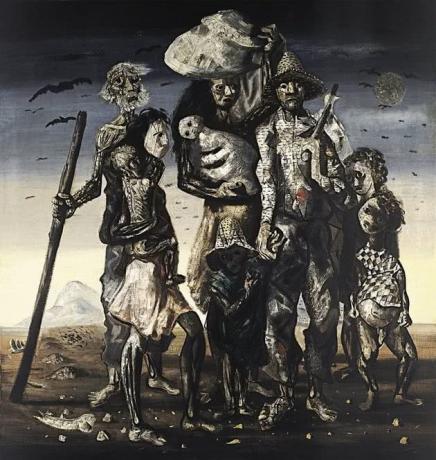
the retreatants it's a work of the painter Cândido Portinari, born in the interior of São Paulo, in the city of Brodowski.
The canvas was created in 1944 and portrays a family of migrants, people who move from the Northeast region to other places in the hope of escaping drought, poverty and infant mortality.
The way in which the artist displays the thin, exhausted and pained expression bodies in an arid and gray landscape is impressive.
There are vultures flying over people, as if awaiting their death. Children are portrayed malnourished and sick - note the boy on the right side who has a belly out of proportion to the body, a sign of a watery belly.
We can make a parallel between this work and the literary work Vidas Secas, produced years before, in 1938, by the writer Graciliano Ramos and which deals with the same theme.
Portinari was a great artist who had, among other concerns, value the Brazilian people and denounce the country's social problems.
15. Abaporu from Tarsila do Amaral

abaporu is a production by artist Tarsila do Amaral, a prominent figure in the Brazilian modernist movement.
The work's name is of indigenous origin and, according to the artist, means "anthropophagous" - which is the same as cannibal. It was as a result of this work that Oswald de Andrade, Tarsila's husband and also an artist, defines the bases of anthropophagic theory for modern art in Brazil.
Such theory proposed that Brazilian artists drink from the source of European avant-garde movements but develop a production with national characteristics. A famous phrase that defines the period is:
Only anthropophagy unites us.
Abaporu brings the value of manual work, with hands and feet highlighted. The strong colors, the cactus and the sun also allude to the tropical climate and landscape.
Read too: Modernist works by Tarsila do Amaral



